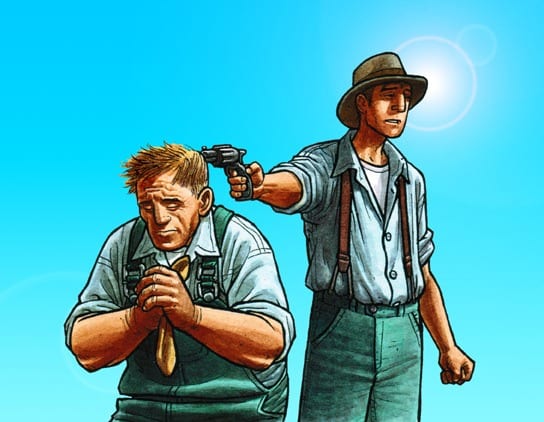
Are Humans Naturally Violent
Updated Dec 31, 2023
“Are Humans Naturally Violent?” has been a subject of intense debate among anthropologists, psychologists, and sociologists for decades. This query delves into the core of human nature, seeking to understand whether our propensity for violence is an inherent trait or a product of our environment and experiences. Exploring this topic is not merely academic; it has profound implications for understanding ourselves, our societies, and the potential for peace and conflict.
In his book The Better Angels of Our Nature, renowned psychologist Steven Pinker argues that violence has declined over time, suggesting that humans are not inherently violent. He points to the development of empathy, self-control, and reason as factors contributing to reducing violence in modern societies. Pinker’s work draws on insights from evolutionary psychology, suggesting that our capacity for cooperation and altruism has significantly shaped human behaviour.
On the other hand, psychologist and primatologist Richard Wrangham, in his book “The Goodness Paradox,” proposes that humans have evolved to be both cooperative and violent. He argues that our ability to form coalitions and engage in proactive aggression has been a key factor in our evolutionary success. Wrangham’s work is rooted in studying chimpanzees, our closest genetic relatives, who exhibit both cooperative and aggressive behaviours.
In his book Beyond War, psychologist and anthropologist Douglas P. Fry presents evidence from peaceful societies to challenge the notion that humans are inherently violent. He argues that the prevalence of peaceful societies demonstrates that violence is not an inevitable part of human nature and that our capacity for peace is just as strong as our capacity for aggression.
Theories on this subject range widely. Some argue that humans are naturally violent, pointing to our evolutionary history, our closest primate relatives, and the ubiquity of violence across cultures and eras. They suggest that aggression may be hardwired into our genes, a survival mechanism from our earliest ancestors. Others, however, contend that violence is a learned behaviour shaped by social, cultural, and environmental factors. They argue that humans, like all creatures, are capable of violence and peace, and our behaviours are primarily determined by the circumstances in which we find ourselves.
In this discourse, we will delve into these perspectives, examining the evidence and arguments on both sides of the debate. We will explore studies from anthropology, psychology, sociology, and other fields, seeking to shed light on the complex and multifaceted question: Are Humans Naturally Violent?
Unraveling the Nature of Human Violence: Are Humans Naturally Violent
An original study of 1,024 mammal species has confirmed the hypotheses Douglas Fields proposed in his book. The analysis was conducted to determine which animals are the most dangerous and vicious killers of their kind. Well, one does not have to look far; one’s reflection provides the answer.
The poignant and atrocious reality is that humans are the worst there is to offer in the mammalian kingdom. We seem to kill for no apparent reason, rage, jealousy, cold-blooded reasons, etc.
“Our violence transcends that of any other species. Human beings exhibit a propensity to kill indiscriminately. Killing is a defining trait of our species, extending to all living beings, including our own kind. The media primarily serves to chronicle our acts of violence. While violence exists in the animal world, its scale is vastly different.
Carnivores kill for sustenance, whereas we kill our own family members, friends, and strangers. Our killings extend beyond mere survival; they encompass revenge, advantage, entertainment, and even self-destruction through suicide. We see killings in various forms, from historical spectacles like the Roman Coliseum to modern-day drive-by shootings and hunting for sport. Children also become perpetrators and victims of violence. The cycle of killing extends to all generations and relationships.”
Why Are Humans Naturally Violent
This transcript provides some insights into this deadly and troubling topic; it shows no signs of abating, and the trend appears to be in full swing.
The Dual Nature of Cruelty: Dehumanization vs. Recognition
Many people attribute cruelty to the process of dehumanization. They believe that failing to acknowledge the humanity of others leads to atrocities such as genocide, slavery, and other forms of evil. I don’t completely disagree with this notion. Indeed, many terrible actions committed against others stem from the failure to see them as fellow human beings.
However, in my New Yorker article, I argue that this perspective is incomplete. A significant portion of the cruelty we inflict on each other, the truly savage and despicable acts, actually arises from recognizing the other person’s humanity. We view them as accountable, morally responsible, and capable of cruelty themselves. We perceive them as withholding what we deserve or unfairly taking more than their share. Consequently, we treat them horribly because we see them as fully moral beings.
Sean Illing Explores the Question: Are Humans Naturally Violent?
I’ve always thought a campaign of genocide or slavery requires two things — an ideology that dehumanizes the victims and a massive bureaucracy.
Paul Bloom on Humans and Violence
The truth lies in a middle ground. I disagree that those actions are necessary. In my view, many mass killings occur as you described – individuals commit these acts without perceiving their victims as fellow human beings. This phenomenon is referred to as instrumental violence, where the perpetrators have a specific goal in mind and see others as obstacles rather than recognizing their humanity.
This is obviously what happened in the Nazi concentration camps. People were reduced to machines, treated like animals for labour. But a lot of what goes on in concentration camps is degrading and humiliating, and it’s about torturing people because you think they deserve it. It’s about the pleasure of being dominant over another person.
But if you merely thought of these people as animals, you wouldn’t get that pleasure. You can’t humiliate animals — only people. So dehumanization is real and terrible, but it’s not the whole picture.
Sean Illing
What does that say about us, our psychology, and our susceptibility to this kind of violence?
Paul Bloom
Think about it this way: We’re all sensitive to social hierarchies and to a desire for approval and esteem. So, we often fall to the social pressures of our environment. That’s not necessarily evil. I come into my job as a professor, and I want to do well. I like the respect of my peers. There’s nothing wrong with that.
But our desire to do well socially can have an ugly side. If you can earn respect by helping people, that’s great. If you can earn respect by physically dominating people with aggression and violence, that’s destructive. So much depends on our social environment and whether it incentivizes good or bad behaviour. Full Story
Why are Teenagers Killing Each Other
Regarding the question of whether humans are naturally violent, it could be argued that incidents like teenage violence lend some support to that claim. The story below serves as just one example among thousands, illustrating how today’s teenagers seem to be resorting to violence more frequently.
The aftermath of Amaan’s murder, which occurred near the secondary school he attended, was marked by the presence of a police forensics tent. In a display of grief and anger, young individuals wearing hoodies and masks clashed with law enforcement while paying their respects. Additionally, it has become customary for Amaan’s friends and peers to update their social media profile pictures with photos of him following his tragic death on the streets of London.
One tribute posted on Instagram powerfully expressed the harsh reality these teenagers face in their environment: “We grew up on a dirty and challenging street. Just four days ago, we were discussing how many of our friends we’ve lost. You warned me that one of us would be next, and sadly, you were right. I’ve witnessed too many friends fall victim, and it has to stop. I can’t bear the pain any longer. Farewell to a true driller and warrior. Rest in power, dear angel.”
While this incident exemplifies the disturbing prevalence of violence among today’s youth, it is essential to remember that individual actions do not necessarily define the innate nature of all humans. Various factors shape human behaviour, and violence can stem from a complex interplay of societal, environmental, and personal influences. To gain a deeper understanding, it is crucial to consider a broader range of data and research to develop effective strategies for addressing and preventing violence in our communities.
“We grew up on a dirty and fucked strip. I was with you only four days ago talking about how many man we lost,” said one tribute posted on Instagram. “You said to me that one of us man were gonna be the next and subhanallah you wasn’t wrong. I’ve seen too many friends of mine drop and it needs to stop I can’t take it anymore angel. Farewell to a true driller and warrior. Rest in power.”
Unraveling Tragedy: Addressing Youth Violence in the Streets of London
It is evident that the tragedies unfolding on the streets of London, particularly among the working-class and young individuals, are deeply distressing and a tremendous loss of life. The recent example of Amaan’s murder, along with two other teenagers within just three days at the start of April, highlights the urgent need to address the issue of violence affecting the younger population.
Within a span of nine weeks, the capital has witnessed 19 homicides involving victims under the age of 25, with nine of them not even reaching their 20th birthdays. Disturbingly, most of those who lost their lives were young black men, echoing a similar pattern observed in 2017 when teenage homicides saw a significant increase nationwide, resulting in the deaths of 27 teenagers. These numbers haven’t been this high since a decade ago in 2007 and 2008 when once again, the victims were primarily black youngsters residing in deprived neighborhoods.
Though statistical data might not be required to grasp the gravity of these fatalities, it becomes evident that addressing this issue requires a comprehensive understanding of the underlying factors contributing to violence among the youth. Addressing the root causes and implementing effective strategies to support and uplift marginalized communities is crucial in curbing this heartbreaking loss of life and fostering safer environments for the young population. Full Story
Conclusion
Whether humans are naturally violent remains a complex and contentious topic, stirring debates among scholars and researchers across various disciplines. Some argue that violence is an inherent trait deeply rooted in our evolutionary history, while others contend that it is a learned behaviour shaped by our social and environmental surroundings. Evidence suggests that humans have a capacity for both violence and peace, and a combination of factors influences our actions. The exploration of this question has significant implications for understanding human nature, societal dynamics, and our potential for peace or conflict. Further research and discussion are needed to gain deeper insights into this fundamental aspect of human behaviour.
Other Articles of Interest

The Mob Psychology: Why You Have to Be In It to Win It

What Is Collective Behavior: Unveiling the Investment Enigma

What is the Rebound Effect? Unlock Hidden Profits Now

Dividend Collar Strategy: Double Digit Gains, Minimal Risk, Maximum Reward

Dividend Capture Strategy: A Devilishly Delightful Way to Boost Returns

BMY Stock Dividend Delight: Reaping a Rich Yield from a Blue-Chip Gem

Define Indoctrination: The Art of Subtle Brainwashing and Conditioning

What Is the Velocity of Money Formula?

What is Gambler’s Fallacy in Investing? Stupidity Meets Greed

Poor Man’s Covered Call: With King’s Ransom Potential

How to Start Saving for Retirement at 35: Don’t Snooze, Start Now

The Great Cholesterol Scam: Profiting at the Expense of Lives

USD to Japanese Yen: Buy Now or Face the Consequences?

How is Inflation Bad for the Economy: Let’s Start This Torrid Tale



